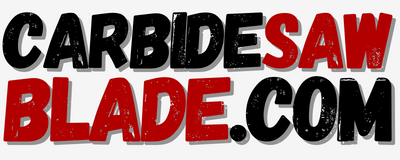Modern table saw blades are primarily brazed with tungsten carbide teeth, which consist of equal parts tungsten and carbon. Tungsten carbide is twice as hard and twice as dense as steel, making it suitable for cutting various materials such as wood, dense composites like Corian™, and non-ferrous metals including aluminum, copper, and brass. Its exceptional hardness allows for long-lasting sharpness in woodworking.
Sharpening carbide blades requires diamond tooling, as carbide is too hard for conventional sharpening methods. When sharpening becomes necessary, we recommend sending your saw blades to a professional sharpening service that utilizes CNC (computer numerically controlled) technology for precise sharpening. You can find a sharpening shop with a quick Google search.
Selecting the right blade is vital for safe table saw usage and achieving high-quality cuts. There are five types of table saw blades: crosscut, triple chip, rip (for a smooth finish or rough cutting), combination blades (for both simple and planer styles), and dado sets.
Understanding the components and geometry of a blade will enable you to choose the appropriate blade for your specific cutting needs.
In woodworking, circular saw blades are categorized based on their use. There are four common types of blades: crosscut, triple chip, rip, and combination. Various blade geometry combinations are utilized to ensure the safe and efficient cutting of different materials. The tooth pattern on the blade is called a grind, and using the right grind for accurate and safe cuts is essential. We explain the different types of grinds and their applications below.
Crosscutting Saw Blades 
Crosscut blades are designed for crosscuts in solid wood. They use an alternating top bevel (ATB) grind and have a high number of teeth per blade. A typical 10-inch crosscut blade has 60-80 teeth, with 80 tooth blades producing a finer cut. More teeth is not always better.
They should never be used for rip cuts as the large number of teeth and the rake angle require a high amount of force to feed the stock, increasing the potential for kickback and blade wandering. They can overheat and burn the wood if used for ripping solid stock.
ATB Alternating top bevel with a positive rake
This type of saw blade has an alternating top bevel (ATB) that slopes alternately and can come with different degrees of angle. A 15-degree angle is commonly used for crosscut saw blades. The teeth have a positive rake, which means they lean forward to help the blade cut into the material with less pressure. Standard crosscutting saw blades' hook angles are between 5 and 15 degrees positive.HATB High Alternating Top Bevel with a negative rake 
This saw blade has a 30 to 40-degree top bevel with a negative rake, making it ideal for cutting chipboard and tear-out-prone materials like melamine or thin veneered plywood. It's especially effective for clean top and bottom cutting. With 80 to 120 teeth on a 10" blade, it's also great for precise mitre or chop saw applications, particularly for cutting wood mouldings.
Triple Chip Saw Blades 
Saw blades with a triple chip grind are specifically designed for cutting hard and abrasive materials like melamine, composite materials, and non-ferrous metals. Triple chip saw blades resemble crosscut blades, but upon closer inspection, there is a major difference in tooth geometry. The teeth do not have an alternating top bevel. They have a flat tooth followed by a tooth with a bevel on each side. This "triple chip" tooth is slightly higher than the flat tooth. The triple chip tooth breaks the chip, and the raker (flat) tooth comes in to clean it out. This feature helps protect the brittle carbide teeth from being damaged or worn out prematurely by hard materials. Although this blade efficiently cuts materials like melamine, it doesn't produce a clean cut on the backside as ATB or Hi-ATB grinds. Therefore, we recommend using a TCG blade with a scoring blade. Triple chip blades are the only blades recommended for cutting non-ferrous metals like copper, aluminum, and brass.
Ripping Saw Blades 
If you need to rip solid wood along the grain, using a flat top rip saw blade is best. These blades have square teeth on top, with a 20 degree rake angle, and 24 teeth, which allows them to work like chisels and cut very fast through the material. A fairly rough finish is typically the result.Flat top rip saw blades are great for grooving, where you need a flat bottom. However, you can't use blades with a triple chip grind because the triple chip tooth is slightly higher than the flat tooth, which will leave a triple chip shape in your wood.
There are also rip saw blades that are called glue joint finish blades. These saw blades are used for ripping as well. These blades use a triple chip grind with tighter radial and tangential angles to give you a planer finish.
Combination Saw Blades 
Using a different saw blade for crosscutting and ripping can be a hassle, requiring frequent blade changes. Combination blades are available that can handle both types of cuts. However, they may perform better than a blade designed specifically for crosscutting or ripping.Combination blades with evenly spaced teeth produce a decent rip or crosscut and are suitable for general-purpose work. These saw blades are typically ATB or TCG grind with 40 teeth on a 10-inch blade or 48 or 60 teeth on a 12-inch blade.
Combination blades also deliver closer to a planer-finish with a tooth geometry group of four ATB crosscutting teeth with one raker tooth—a large gullet after the raker tooth provides space to remove more material simultaneously. A quality planer combination blade can produce a great cut if kept sharp and clean.
If ripping dense wood or if the material is thick, it is better to change the saw blade and use a dedicated ripping blade as both the performance and safety are reduced.
